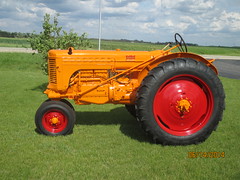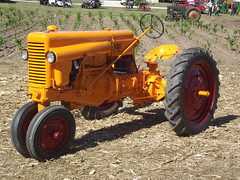An Industry Leader
As we progress into the 21st Century Twin City tractors have become highly prized collectibles with industry leading history. Perhaps the most influential design would be the 12-20. This tractor was engineered and advertised for the 1919 market year; however it is possible that ink and paper were moving to design this machine as early as 1917. By October 1918 warehouses at the Lake Street plant were full and 12-20's were already being delivered to dealers and sold to the public.
This was Minneapolis Steel & Machinery Company's first lightweight machine and was re-rated to 17-28 in 1926. It was still available through 1935, for a total production run of 17 years. The 12-20 set a designing trend for other Twin Cities and direct relationships between the 12-20 and MM tractors were apparent until 1960. This 5000 lb. machine used a vertical 4 ¼ X 6 4 cylinder 340 cubic inch engine that posted unusually high fuel economy through the use of dual camshafts and 4 valves per cylinder. At 1000 rpms 3 gallons of kerosene would produce 18.5 drawbar hp, and 28 belt pulley hp for a full hour. Two forward speeds of 2.2 and 2.9 mph were used.
When the Company's books were closed on New Year's Eve of 1919, 2900 12-20's had already been sold. Year to year breakdown of serial numbers is nearly nonexistent, but here is what we do know.
• Nearly one third of total production was sold by the end of 1919, production tapered off, and it took six more years to sell the other two thirds.- Beginning serial number for 1918 is 10201
• Gas starting tank was placed under the hood from # 10707 to 17034
• Starting tank was mounted vertical behind main tank from # 17035 on
• First 1,010 units used a Bosch D.U. 4. magneto with large external impulse starter
• First 1,900 units used a spring loaded Borg & Beck clutch. Over center Twin Disc starts at # 12100
• In June of 1920 # 12278 was delivered to Nebraska test lab. Results are posted under test # 19
• First 5,040 made used a Pierce governor, 8 spoke front wheels, 2 piece hand crank, and early double hump or "M" shaped intake manifold
• In 1924 carburetor and manifolding updates increased power output. Engine castings and internal dimensions remained the same
- On December 4th, 1925 production had reached #18733
• Chassis #'s 18734 - 19219 were used from December 5th, 1925 to May of 1926
• Total production from 1918 to 1926 was just over 9,000 units using serial #'s 10201 - 19219
~Tony Thompson









Hi DaveThanks for your note. The primary digsen criteria of the FUNcube Dongle was to provide an educational outreach tool to allow access to the FUNcube satellite in a simple and reasonably priced way. As part of this we have worked hard to both keep the cost down and make it plug and play. With these axioms, we ended up using parts that have intellectual property that demand the signing of a non-disclosure agreement.As such, the FCD has ended up having the added benefit of being a wide band all mode receiver with many more uses than it was originally digsened for and even more that we haven't even dreamt up yet.We thought long and hard about using parts with associated NDAs. At the end of the day, the primary requirements were to keep costs down and provide plug and play capability. Providing schematics, firmware and detailed PCB layouts is, I am afraid, not possible under the NDA. Even without an NDA, I am not sure just how many people out there would have workshop capabilities and be confident enough to make boards with QFN parts.Believe me, this is scary stuff! I have built 13 so far. Even now, all are met with trepidation, although I'm getting better, the last seven have worked first time. That is not before getting rather blase9 yesterday when I positioned and soldered a 0.5mm pitch 32 pin QFN at 90 degrees to true: luckily I noticed during construction of other parts. Rather a schoolboy error, but equally if you are not very careful, and without the right equipment, the whole board would have been destined for the trash.Howard